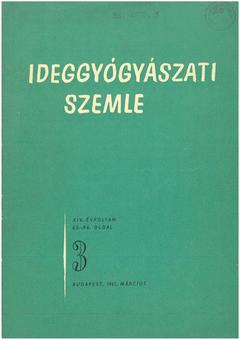The eLitMed.hu medical portal uses computer cookies for convenient operation. Detailed information can be found in the Cookie-policy.
Clinical Neuroscience - 1961;14(03)
Content
[Occipital alexia and polyopia ]
[Description of one case each of polyopia with right- and left-sided occipital focus. Overview of pure alexia cases. Relationships between gaze disorders and positive afterimages are sought. Alexia represents an asymbolia, i.e., it is a purely optic-gnostic disorder. ]
[Light effect-induced reflex epilepsy (Epilepsy photogenica and its borderlands) ]
[1. Ph. e. is a distinct form of reflex epilepsy in which rhythmically repetitive or unexpected light effects regularly provoke clinical and EEG phenomena characteristic of epilepsy. 2. From patient-specific provoking light effects to stimulus-independent seizure forms to other (mainly central) seizure types and so-called stimulus-sensitive "myoclonus", transient forms occur. 3. Ph. e. is characterised by focal or initially generalised epileptiform EEG phenomena in response to specific light effects in each patient, but the clinical paroxysm is often distorted by vegetative symptoms, functional-appearing behavioural disturbances, myoclonus, etc. 4. Ph. e. may be due to defects in inhibitory mechanisms. It can be assumed that in central seizures, light stimuli cause a dysfunction of the mesencephalic reticularis of the tegmentum : the activity that centrifugally selects and centrally controls and processes the sensitive impulses is reduced or eliminated. In a cortical type seizure, local inhibition of the visual cortex leads to blurring. Author 5 reports observations on a case of 22 ph. e.-s 4 fronto-polar photo-myoclonias. 6. Atypical seizure phenomena and frequent lack of subjective photosensitivity often make it difficult to recognize the true nature of the disease, which not only makes it impossible to adjust appropriate treatment, but also makes it impossible to take preventive measures in patients exposed to sudden light effects (e.g. in public traffic, etc.). It is therefore appropriate to exclude or confirm the pathology of ph. e. in a wide variety of paroxysmal conditions by using intermittent light stimuli during EEG examination. ]
1.
Clinical Neuroscience
[Headache registry in Szeged: Experiences regarding to migraine patients]2.
Clinical Neuroscience
[The new target population of stroke awareness campaign: Kindergarten students ]3.
Clinical Neuroscience
Is there any difference in mortality rates of atrial fibrillation detected before or after ischemic stroke?4.
Clinical Neuroscience
Factors influencing the level of stigma in Parkinson’s disease in western Turkey5.
Clinical Neuroscience
[The effects of demographic and clinical factors on the severity of poststroke aphasia]1.
2.
3.
4.
5.



